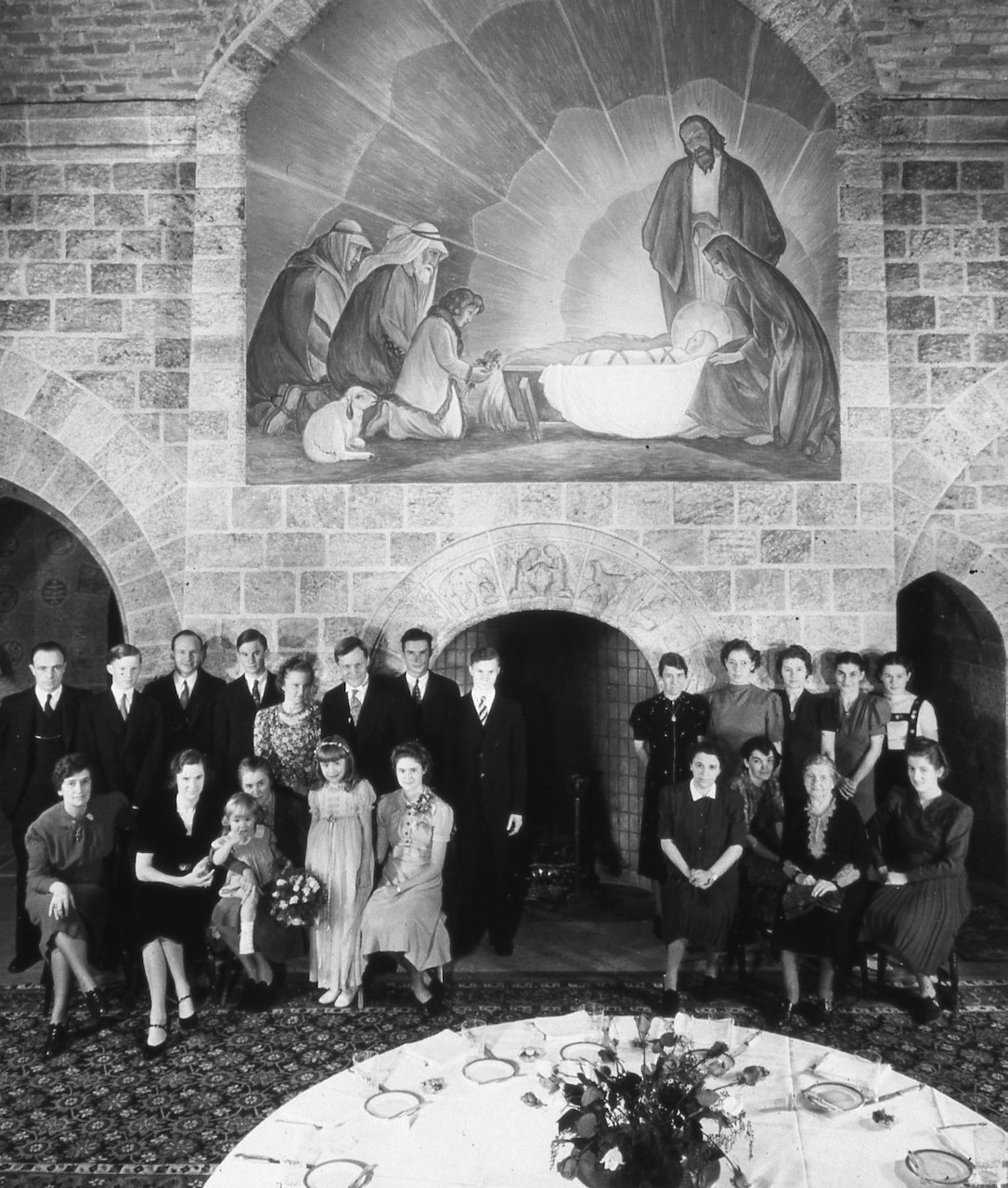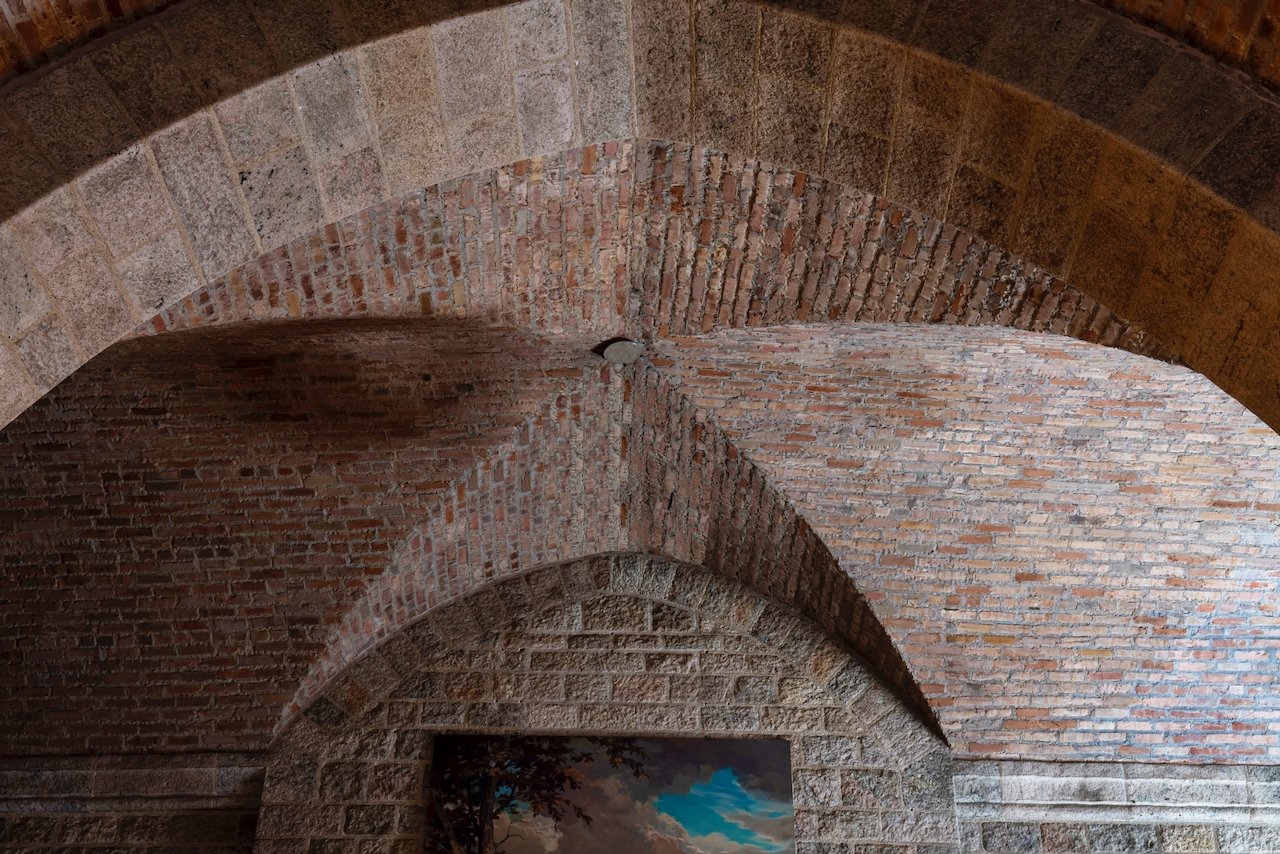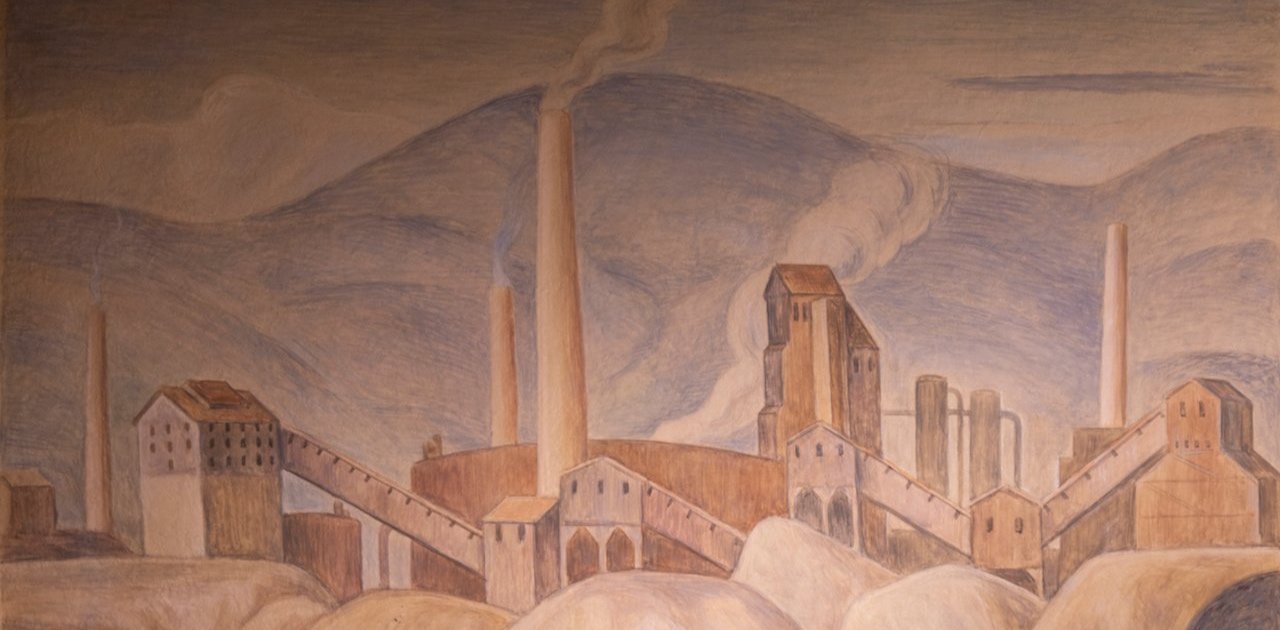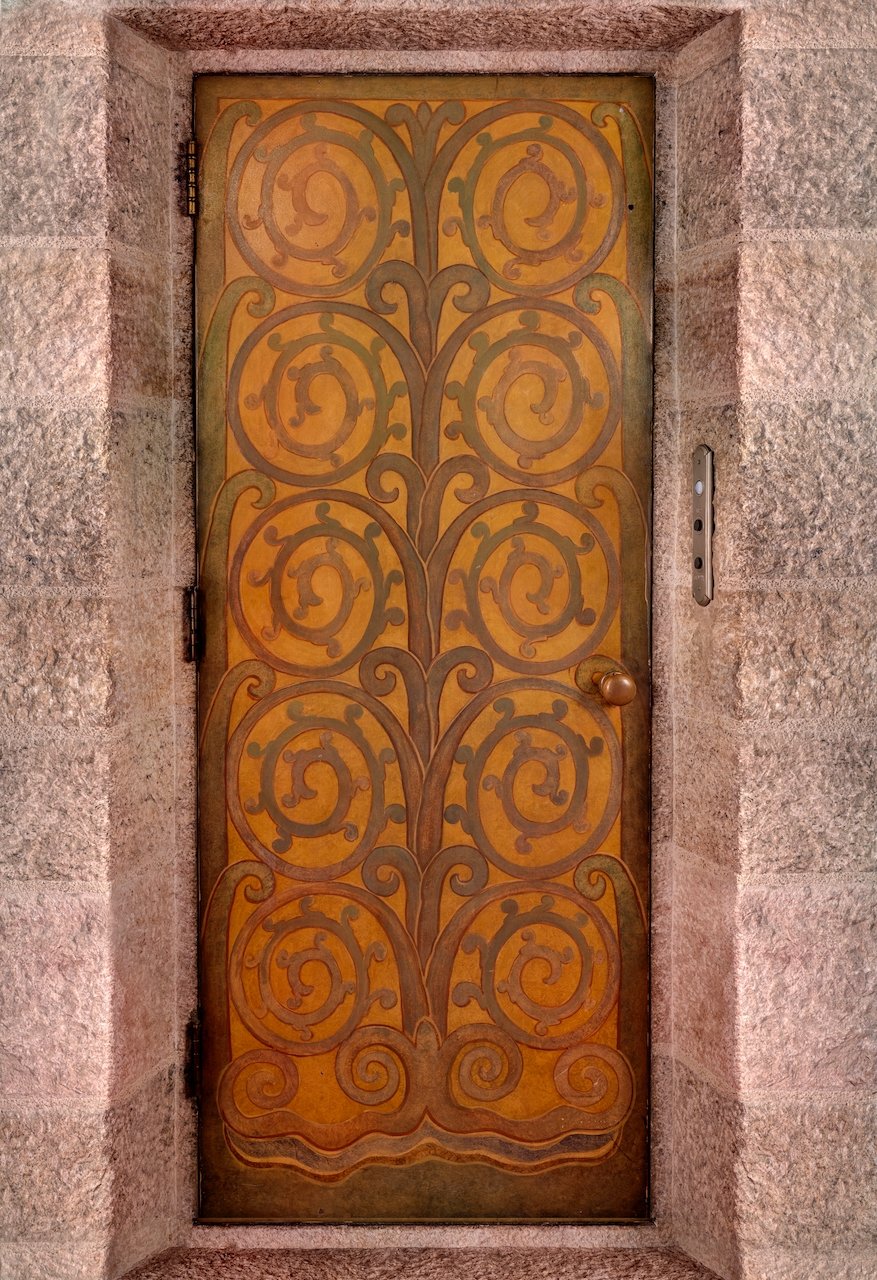Glencairn Museum News | Number 8, 2022
Left: The plexiglass lampshade, with medieval-style scenes of the hunt, was painted by Frank Snyder. It is currently in Glencairn’s Great Hall. Right: The photograph of Snyder is courtesy of the U.S. Army Corps of Engineers, Philadelphia District, and the Marine Design Center.
Frank (Francis) Eugene Snyder (1908–1995) was born on September 10, 1908, in Altoona, Pennsylvania. One account of his life states that he “was a proficient boxer in his teens, and at one time contemplated boxing professionally, but turned to art instead” (Unpublished, typed biographical notes. Bryn Athyn Historic District Archives). In the late 1920s, he went to Italy to study art in Rome. He remained in the country until the mid 1930s. While in Italy, he became proficient in the language and found various jobs painting and drawing. After returning to the United States, he worked for Armando T. Ricci, a well-known interior decorator in Philadelphia. Ricci was particularly known for his work on the interiors of Philadelphia’s grand movie theaters during their golden age, including the historic Boyd Theatre. In 1937 Snyder began to work for Raymond Pitcairn at Glencairn.
Figure 1: Pitcairn family, friends, and Glencairn staff pose in front of the Upper Hall fireplace during the 1939 Christmas season. Snyder’s adaptation of the Adoration of the Shepherds hangs above them.
Adoration of the Shepherds painting on canvas
Sometime between 1937 and 1939 Pitcairn asked Snyder to work on a life-sized oil painting on canvas (12’x12’) depicting the Adoration of the Shepherds from the biblical story of the birth of Jesus Christ. It was an adaptation of an illustration (Figure 2) in a children’s book, The Christ Child, published by Maud and Miska Petersham in 1931. This husband-and-wife team were well known illustrators and authors of children’s literature in the first half of the 20th century. The Pitcairns loved their work, especially The Christ Child, and in the 1950s Raymond Pitcairn wrote to the couple that he and Mildred believed it was “the best Gospel book for children that has ever been produced.” With their permission, Pitcairn commissioned Snyder to paint a large-scale adaptation of the Adoration of the Shepherds to hang in the dining area of Glencairn, their new home, during the Christmas season. A photograph from 1939 (Figure 1), the first Christmas they celebrated at Glencairn after they moved in, shows Snyder’s painting hanging above the fireplace in the Upper Hall.
A comparison of the Petersham’s two-page illustration in the book (Figure 2) and Frank Snyder’s adaptation of it (Figure 3) reveals that many changes were made from the original. Pitcairn would have worked closely with Snyder to decide on the changes that suited his purposes and personal taste. In general, these changes involved simplifications and colors. In the Petersham original, Mary has a blue gown with a colorful embroidered pattern on the sleeve and a white shawl. In Snyder’s rendering, she has a simple red gown and a blue shawl. Joseph’s clothing also underwent changes. In the original, he has a blue and white striped undergarment and a blue outer garment with woven detailing around the collar. Snyder’s Joseph, on the other hand, has a brown outer garment and an all-white undergarment. A comparison of the three shepherds reveals similar changes in clothing. In addition, there was clearly no attempt made to copy the faces as they appear in the book. The faces of the shepherds and the Holy Family in the Petershams’ original possess a rosy-cheeked sweetness that is not apparent in Snyder’s adaptation; his faces are slightly more somber. Perhaps Pitcairn wanted a figural style that blended more comfortably with his medieval-style home and artworks and colors that would read better on the granite wall behind the painting.
Figure 2: A first edition (1931) of The Christ Child, opened to a two-page spread with the Adoration of the Shepherds.
Sadly, Snyder’s adaptation of the Petershams’ Adoration of the Shepherds has not survived intact; in the 1980s it was found to be in a state beyond repair. However, thanks to a generous donation, in 2015 a new adaptation was made by Bryn Athyn artist Edwin Herder. Herder was inspired by both the Petershams and Snyder for his own unique rendering.
Figure 3: A color slide from 1961 shows Snyder’s adaptation of the Adoration of the Shepherds hanging above the Upper Hall fireplace.
The Doctrine of Charity mural in Michael Pitcairn’s bedroom
A few steps up from the chapel, on Glencairn’s fifth floor, is a room with a stunning view of Bryn Athyn Cathedral. It was designed as a bedroom for Michael Pitcairn, one of Raymond and Mildred’s sons, and is notable for the large mural that wraps around the top of the walls (Figures 4 and 5). The mural was painted in transparent oils by Snyder with passages paraphrased from one of Emanuel Swedenborg’s theological books, The Doctrine of Charity. The passages accompany scenes depicting the countryside, Glencairn (Figure 8), industry, the Capitol Building, the White House, the Supreme Court Building (Figure 6), the New York city skyline, Bryn Athyn Cathedral (Figure 7), and a view of the Catskill mountains, where the Pitcairns built their summer home. In 1983 Snyder was interviewed by E. Bruce Glenn, Pitcairn’s nephew. Snyder described the design process for this impressive project:
“All the designs were worked out on large pieces of paper, right here in this room [Michael’s bedroom]. The lettering style was developed here in conference with Raymond Pitcairn. We decided he wanted a style that was unique to the room and to the matter that we’re illustrating. So, we worked for many hours, an easel was set up and we sketched alphabets and words and wrote some sentences. We finally arrived on something that had a hint of seraphs; was pretty plain that did not conflict with the medieval style, and followed through the general feeling of decoration. The text from Doctrine of Charity was prepared for the spacing by Dr. [William] Whitehead, and he also worked right in this room with us to discuss how the disposition should be made of the text placement. Text is all in letters of golden leaf, which is superimposed over very soft blue-grade panels. The panels were painted in beforehand, and then the cartoons were pounced through perforated stencils onto a background, then the sizing was set on each letter, then gold leaf attached to the size. There’s nothing photographic or realistic, most of it is more or less symbolic, it’s idealized. Such is the Capitol and the placement of the White House and the Justice Building; they’re not intended to be portraits of the real thing, they’re exaggerated to some extent and symbolized. So also the skyline of New York would never look like that, and the ships that appear on the right hand side of that panel would be entirely out of scale, but they are symbols” (Interview, 1983, Bryn Athyn Historic District Archives).
Figure 4: This photograph of a portion of the Doctrine of Charity mural in Michael Pitcairn’s room shows a section of the north wall (left), the east wall (front), and a section of the south wall (right). The text for the wrap-around mural formally starts on the section of the south wall that is shown in this photograph. It is then interrupted by a large window on the south side of the room and continued on the other side.
Figure 5: This photograph of a portion of the Doctrine of Charity mural in Michael Pitcairn’s room shows a section of the south wall (left), the west wall (front), and a section of the north wall (right). To the left of the text on the south wall, beyond the photograph, is the large window that interrupts the mural on that wall.
During the interview with Glenn, Snyder asked him to characterize in a general way the religious subject matter of the mural from a Swedenborgian perspective. This was Glenn’s reply:
“It represents the Doctrine of Charity as presented by Swedenborg, and the various murals and texts describe different occupations and professions and what is characteristic of a person who does them from charity, charity being the love of use, the love of doing a good job for the sake of the neighbor, and for the sake of the commonwealth. So that it includes the need to have the Lord’s presence, what is Divine, the need for justice, civil and social justice, the need for health and industry in cities and farms, and so forth, and these are represented by the home, Glencairn itself, by the Cathedral, by the national Capitol, and the three branches of government there, by scenes from the Pitcairn home in the mountains, and the New York skyline and the Statue of Liberty.”
Figure 6: A detail from the Doctrine of Charity mural that depicts an idealized version of the Capitol Building, the White House, and the Supreme Court Building.
Figure 7: A detail from the Doctrine of Charity mural that depicts Bryn Athyn Cathedral. Figure 19 reveals how this mural influenced several Christmas card designs by Snyder.
Figure 8: A detail from the Doctrine of Charity mural that depicts an idealized version of Glencairn set among rolling hills and woodlands.
The full length of time required to paint the mural is not known, but archival records show that Snyder was working on it in October and November of 1938. William Fesmier (1882–1962), a superintendent during that period, kept detailed handwritten notes of all the projects that were being worked on from day to day, and these brief notations mention the progress being made on the mural. For example, “October 13, 1938. Frank still working on Mickey’s room on the south wall now.”
Figure 9: Snyder painted this plexiglass lampshade with scenes from the arts; the panels seen here (left to right) depict drama, music, and architecture.
Painted plexiglass lampshades
During the 1983 interview with E. Bruce Glenn, Snyder discussed six different lampshades he had painted. One of them, made out of paper, depicted a variety of birds, but the other five were made from plexiglass, a new material that began to be marketed in the early 1930s. The company that produced the individual plexiglass panels for the lampshades was Charles Ware of Feasterville, Pennsylvania. Some of the shades have a metal frame to support the plexiglass panels, while others are made entirely of plexiglass. Today four of these unique lampshades are still on display in Glencairn. Two of them are in the Great Hall and two are in the Chapel on the fifth floor.
According to Snyder:
“The intention was to produce somewhat of a stained-glass effect when light was on from the interior of the shade. When that was extinguished, it was desirable to have the material legible, in the matter of an opaque painting, or semi-opaque. As a manuscript might be illuminated. The style was, of course, medieval inspired by the old glass” (Interview, 1983, Bryn Athyn Historic District Archives).
The subject matter on the two lampshades currently on display in Glencairn’s Great Hall (Figures 10 and 11) depicts medieval-style scenes of the hunt for one shade, and symbols related to the New Church for the other. The lampshade with scenes of the hunt has a metal frame that was designed by Parke E. Edwards, the preeminent metal designer for Glencairn.
Figure 10: This plexiglass lampshade was painted by Snyder with medieval-style scenes of the hunt. The metal frame was designed by Parke Edwards, the preeminent metal designer working for Pitcairn.
Figure 11: This plexiglass lampshade was painted by Snyder with symbols of the New Church.
Two more Snyder lampshades are on display in Glencairn’s Chapel (Figures 12 and 13). One has symbols taken from the seal of the Academy of the New Church, which was developed in 1878, and the other has scenes from the story of Christ’s birth. Both of these lampshades are made entirely of plexiglass. In order to get the exact shape they were looking for in the individual plexiglass panels, Snyder carved a mold out of plaster of Paris. Each sheet of plexiglass was then cut before being put in an oven on top of the plaster mold so that it would soften and conform to the shape. According to Snyder, the idea came to him when he “saw the effects of a piece of silver draped over a metal shape” (Interview, 1983, Bryn Athyn Historic District Archives).
Figure 12: This plexiglass lampshade was painted by Snyder with symbols of the seal of the Academy of the New Church.
Figure 13: This plexiglass lampshade was painted by Snyder with scenes from the biblical story of Christ’s birth.
Snyder’s description of exactly how the lampshades were painted is rather technical, but the basic formula seems to have included diluted oil paints, drying agents, ice, and alcohol to achieve “a textured effect that is somewhat reminiscent of the stained-glass feeling” (Interview, 1983, Bryn Athyn Historic District Archives).
Painted bricks on the Upper Hall ceiling
A casual look at the brick ceiling in Glencairn’s Upper Hall (Figure 14) might lead the observer to believe they are looking at nothing more than the original color of the individual bricks. In fact, the bricks in this ceiling were carefully painted by Snyder. In his interview with E. Bruce Glenn, a picture emerges of how it all came about:
“. . . . Raymond Pitcairn decided that we might do something with the uniform color of the brick, to give it a little more interest. So, a scaffold was put up and I got up with a dozen or so cans of thinned out decorator’s flats [matte finish?], mixed in a number of subdued pastels. While he commented from the floor, I tried various combinations in small sections of two, or three, square yards. Then when we hit on a feeling that he liked, we expanded that to the whole ceiling. And perhaps what we have achieved is a different kind of a mosaic effect, lightening up the heavy effect that the monotonous brick tone would have had.”
Snyder’s mention of “a different kind of a mosaic effect” alludes to the fact that originally the plan had been to cover the Upper Hall ceiling with mosaic.
Figure 14: The brick ceiling in Glencairn’s Upper Hall was originally intended to have mosaic, but that plan was abandoned. Snyder was then asked to paint the bricks “to give it a little more interest” (Interview, 1983, Bryn Athyn Historic District Archives).
Illustrations for the book, Today We are Americans All
Figure 15: The cover and illustrations for the book, We are Americans All, were done by Snyder.
Today We are Americans All (1941) is a self-published book written by Pitcairn, with illustrations by Snyder. It was intended to be handed out to new naturalised citizens in Philadelphia, and eventually, Pitcairn hoped, to a wider audience. In his foreword, he states that its purpose is “to discuss what it means to be an American citizen—what it means to you, and what it has meant to countless others who here found room for growth and achievement. The purpose is to outline what America offers you in terms of Opportunity—and what America expects of you in terms of Loyalty and Responsibility and Service” (pp. 3–4).
Pitcairn was happy with Snyder’s work on this project:
“Dear Frank,
Enclosed are four copies of the special Christmas edition of ‘Americans All’. You can well be proud of your contribution to the work. I am most happy over the illustrations. In the next edition the tint blocks should be better. We were much rushed in order to have the first few out for Christmas” (Raymond Pitcairn. Letter to Frank Snyder. 2 January 1942).
The book was published during the tumultuous time following the Japanese attack on Pearl Harbor and the country’s entry into World War Two. In fact, the first printing was intended to include a foreword by Associate Justice Owen J. Roberts, but the foreword had to wait for a later printing because he was heading up a committee to investigate the Pearl Harbor attack.
One of the drawings in the book is reminiscent of a scene painted by Snyder for the mural in Michael Pitcairn’s room, depicting an industrial complex of buildings with tall smokestacks (Figures 16 and 17).
Figure 16: This illustration from the book Today We are Americans All is reminiscent of a scene from the mural Snyder painted (see Figure 17).
Figure 17: A detail from the Doctrine of Charity mural that depicts industry.
During this same time, Snyder was consulting with Raymond Pitcairn about trying to reapply to the War Department. (He had previously been turned down, but was now trying again.) Pitcairn offered him the following advice:
“. . . It would be well to write a letter to accompany the papers, saying that you had made a former application, giving the time and place, and adding that at that time, however, you desired to reside in the United States and trusted that your wife might live nearby; but that now you are ready and willing to go where the Army could best use you and you feel your knowledge of the Italian people and your facility in Italian, as well as a knowledge of Spanish and some French, would enable you to be of real use in the Mediterranean area” (Raymond Pitcairn. Letter to Frank Snyder. 27 October 1942).
Snyder’s second attempt, whether or not it was ever formally submitted, was also unsuccessful, but he was subsequently able to contribute to the war effort by working in the aviation industry.
Christmas card designs
Figure 18: Raymond and Mildred Pitcairn’s 1940 Christmas card was designed by Snyder.
Raymond and Mildred Pitcairn sent out Christmas cards every year to a large list of family and friends. The cards were often designed by artists working for the Pitcairns, and between 1938 and 1956 Snyder designed seven of their cards. His skill with calligraphy, as well as painting and drawing, made him especially well suited to produce unique card designs. It is also clear from an examination of the cards themselves that certain designs were repeated, and that other projects he was working on often provided source material.
In 1938, the same year that Snyder was painting the mural in Michael Pitcairn’s room, he designed a card (Figure 19) that is an almost exact replica of the scene in the mural depicting Bryn Athyn Cathedral (Figure 7). This design was used on Christmas cards again in 1939 and 1945.
The calligraphy Snyder produced for a card in 1944, including an inhabited initial letter “A” in the style of medieval manuscripts, was adapted and used again for the inside of the 1954 card (Figure 20). The initial is inhabited by an Adoration of the Shepherds scene that was clearly inspired by the plexiglass panel he painted for the Christmas-themed lampshade (Figure 21).
The front of the 1954 card (Figure 22) is a photograph of Raymond and Mildred Pitcairn sitting in front of the Upper Hall fireplace with Snyder’s adaptation of the Adoration of the Shepherds above them.
Figure 19: The Pitcairns’ 1939 Christmas card, designed by Snyder, has a scene of Bryn Athyn Cathedral that is almost an exact replica of the scene in the mural (Figure 7). The image was used for Christmas cards in 1938, 1939, and 1945.
Figure 20: The inside of the Pitcairns’ 1954 Christmas card was designed by Snyder. Compare the scene in the inhabited initial letter “A” to the plexiglass lampshade panel that Snyder also designed (see Figure 21).
Figure 21: This panel from Snyder’s plexiglass, Christmas-themed lampshade, depicting the Adoration of the Shepherds, provided inspiration for an inhabited initial letter “A” (see Figure 20) that he designed for the Pitcairns’ 1944 and 1954 Christmas cards.
Figure 22: The front of this 1954 Christmas card has a photograph of Raymond and Mildred Pitcairn sitting in front of the Upper Hall fireplace with Snyder’s Adoration of the Shepherds adaptation above them.
Figure 23: One of the exterior doors for Glencairn’s main elevator.
Snyder has also been credited with painting the exterior doors for Glencairn’s main elevator (Figure 23). On each floor there is a different design for the door that is opened to enter the elevator cab.
After his time at Glencairn, from the early 1950s until the early 1970s, Snyder worked as an illustrator for the Philadelphia District & Marine Design Center office of the U.S. Army Corps of Engineers. He was highly regarded as an employee and even today has an entry in their online Gallery of Distinguished Employees. Frank Snyder is further remembered for having been the co-author, illustrator, and driving force behind a book, The District: A History of the Philadelphia District, U.S. Army Corps of Engineers, 1866-1971.
Glencairn is always looking to find out more about the lives and work of the many individuals who worked on both Glencairn and Bryn Athyn Cathedral. If you have further information or photographs of Frank (Francis) Eugene Snyder that you would be willing to share, please contact Ed Gyllenhaal, Glencairn Museum’s curator, at curatorial@glencairnmuseum.org.
(KHG)
Would you like to receive a notification about new issues of Glencairn Museum News in your email inbox (12 times per year)? If so, click here. A complete archive of past issues of Glencairn Museum News is available online here.
























